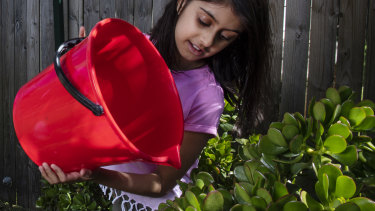
For example, the lime tree, alone among our citrus, has consistently refused to produce fruit. And some plants have made the decision for us, dying before we even noticed. We are so used to a climate looking after our gardens for us.
Our back garden was born in 1993, arising from the crumbling failed redevelopment of a previous owner. The only plant remaining was a dracaena, now tall enough to provide a canopy for a garden crammed with bromeliads, begonias, native orchids and oregano. That original plant competes with a forest pansy, bought because an enthusiast at an open garden told us it was the perfect compact inner city garden tree. He lied. It’s more than 4 metres tall now and the loveliest plant, red heart shaped leaves replacing tiny pink pinprick flowers at the end of spring. Out the front, due west, are the plants we thought could cope with blasting sun and concrete, the euphorbias and other cactusy-looking plants.

Watering from a bucket is mandatory in Sydney under level 2 water restrictions.Credit:Louise Kennerley
To save our garden, we have a little production line with buckets in our house so it's good we have a few adults here – but this kind of watering takes time really only available during holidays. Even our 40-year-old bay tree in a pot is struggling. My spouse has already made the call about which plants will be left to die, and that’s fair because the garden is really his project. I’ve got a couple I’ve grown from tiny cuttings I’ve taken, mostly with permission, one just before a bystander called me to say one of my kids was in an ambulance with suspected spinal injuries. The Herald’s brilliant Robin Powell has some good advice about how to protect your drought-stricken suburban dream.
But not even Powell's wisdom can save one of the most beautiful green spaces Sydney has, the Royal National Park. After an early morning swim at Wattamolla Sunday last, I walked along the Hacking River. The banksias, usually resolute in spite of the weather, are dying, and there’s barely any birdsong. It's the drought, I thought. The Australian Plants Society’s Rhonda Daniels corrects me. She says we must change our mindset. “You can see the impacts of climate change with a gradual reduction in moisture and higher temperatures,” she says. “It’s beyond drought."
Daniels is secretary of the Sutherland Group which completed a list of plants seen on the coast walk in the park 14 years ago and she saw the impact of the 1994 and the 2001 major fires on her much loved park and its plants. “Some plants can resprout and send out leaves really quickly – but if there’s no water at all, the plants just die. The banksias have been hard-hit and a lot are dying, weakened by the drought, it’s very sad for people who love plants. It’s a whole ecosystem, the plants depend on the animals and the animals depend on the plants.”
Loading
I'm even missing mosquitoes and I never thought I'd say that. Guess that's more due to smoke from bushfires than drought. The Department of Planning, Industry and Environment map looks bleak, over half the state in intense drought and none of the state safe from drought impacts. Even a year ago, the red which stands for intense drought, was spreading.
When I asked Sydney Water what would happen next, if and when the drought worsens, the response was that restrictions would get tougher. Maybe, as Powell hints, we could rethink our position on swimming pools, filled with hoses and emptied of people most of the time.
We don't need private pools nearly as much as we need trees and local lemons.






 Add Category
Add Category